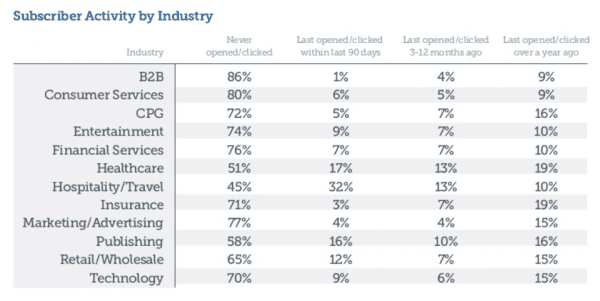Why you could be irrelevant to 86% of your target audience... and what to do about it
86% of B2B email marketing does not work. That’s the average level of non-engagement in B2B email marketing databases - the people who never open, never read and never engage with any of your content.

Yet email remains an enduring pillar of modern business communication with UK workers dealing with an average of 40 emails per day and spending an incredible 81 days of the working year reading and writing emails.
How can email marketing be failing to reach such a large proportion of its intended audience when email communication is still so prevalent? So deeply embedded in our daily work?
It is not email marketing that has become less effective, it is broadcast email marketing that has become less effective. That average of 40 per day masks an uncomfortable truth for many at the sharp end of things; the decision makers, the ones who would consider 45 emails to be a quiet day. The demands of managing a swamped inbox mean that there is little time for anything from unsolicited senders - those broadcasting to the masses in the hope that someone will pay attention.
In a world of email overload, marketers are way down the inbox priority list behind the boss, the clients, the colleagues and the wife or husband.
Getting your email read
How do we get somewhere into some of that 86%‘s list of priorities then? Segment them from your engaged audience and take a fresh look at them and what is going wrong. Why do they consistently and instantly dismiss your emails on arrival?
For the sake of keeping this article slightly shorter than War and Peace, we will make the assumption that there are no deliverability issues with your emails. So, on the basis that the email got to the inbox and the recipient hasn’t ditched all email communication in preference of Yammer or Post-It notes, we are left with the information you present when the email first reaches an inbox.
Who it is from and what it is about – The Sender/From address and the Subject Line are the only things that are going to influence behaviour. They never see your design, your proposition, your call to action or anything else, because they didn’t open the email in the first place.
Who are you?
What is the relationship between you and the recipient? Do they know you? Do they know your company? If not, why are they going to choose your email over the others?
Individual names tend to outperform company names in the sender address field regardless of whether there is a relationship between sender and recipient. Faceless organisation names are instantly dismissed, but individual names tend to spark curiosity in the absence of familiarity. If you have been sending emails from an individual to that non-engaged audience for some time, then try presenting it from somebody else.
The best way to get your From field firing on all cylinders is to use Dynamic Content - Where a relationship exists, leverage it. Map your “account owner / salesperson” field to the contact record and send emails with this value dynamically inserted into the From field.
What’s this about?
The next challenge is the subject line. These few words are often the deciding factor between email marketing success or failure and yet the subject line is often an afterthought.
Search for the word newsletter in your own inbox and I’m sure you will find a surprising number of emails that you’ve never read. Unless you’re one of those “Zero Inbox” types, in which case the newsletters are in the Newsletter folder. Unread all the same.
Think about your target audience, your recipient. Why is this email going to be something they want to invest time in? What makes yours different from the rest?
There are lots of one off tricks for making a subject line stand out from the rest. The latest fad is single word subject lines - once again playing the curiosity card, but gimmicks don’t tend to help with engaging recipients over the longer term. Also, there’s no need to have a keywordfest in your subject line - email has no SEO benefit after all.
Succinct subject lines that a) seem relevant to the recipient and b) make the email sound interesting tend to work best. As the title of this post subliminally suggested, relevancy is the key to unlocking the apathy shown to you thus far by that 86%.
Relevancy can be achieved by chance. For big B2C brands, the numbers game still works. When your marketing database runs into the millions, a fraction of a percentage response rate still delivers a good return on your investment in creating, building and sending a campaign. However, for most B2B brands, their audiences are much smaller and hence the same percentage returns can amount to practically nothing.
You cannot be all things to all people
Genuine relevancy can be tricky, especially if there is an eclectic mix within that 86%. Different industries? Different roles? Different levels of seniority? How can you be relevant to them all at the same time? Very tricky. So am I suggesting that you need to do ten versions of your email?
Yes, but no. Not ten versions. Ten variations maybe. Back to dynamic content again! How could a couple of words influence different groups within your target audience? What if you were to put words in the subject line that related the content to the recipient?
Let’s say that you want to demonstrate your expertise on a topical IT issue within an industry that you are selling to. We will call the subject “X”. Creative, I know... You target both finance and IT roles within that industry as they tend to both be involved in signing off on your product or service. You therefore write your thought leadership piece and build your email to promote it, but you make one subtle change. The last word in the subject is dynamic:
IF Role = IT, THEN Subject = “Impact of X on IT teams ”
IF Role = Finance, THEN Subject = “Impact of X on IT budgets”
Congratulations. You’ve made your subject line dynamically relevant. The content of the email was relevant in the general sense, but you then honed it down to resonate with the individual recipient.
Data driven dynamic content
As Stephen Covey suggested in his seminal book The 7 Habits of Highly Effective People, we should seek first to understand, then to be understood.
If we understand our target audience, we are better equipped to communicate with them in relevant and meaningful terms. Rather than simply plying your wares to all and sundry, you will progress opportunities intelligently and appear more customer centric by leveraging demographic and behavioural data to ensure that the right messages go to the right people at the right time.
Automation beats determination
Now, what about the other eight roles and three industries you target?
To achieve the above example on an industrial scale, you need to approach these things programmatically. With that rich and detailed profile of each contact with multiple values to draw from, you can look to automate communications which draw upon those data values. You get that rich and detailed profile by integrating data sources; your CRM, your website, your telesales team, all contributing to your understanding of those in your database.
That may all sound a bit complicated and resource intensive so if nothing else, do something different with that 86%, even if it is manual. When you do, always split test the changes you make in isolation of any others and review the results. If you change too much in one go, you may not find out which change made the big difference.
For more on best practices for B2B Email marketing, you can download a free copy of CommuniGator’s Complete Guide to Effective Email Marketing.
 Thanks to Dan Hare for sharing their advice and opinions in this post. Dan is a former integrated communications agency director, now heading up customer service at CommuniGator. He helps marketing professionals to deliver automated and targeted campaigns through CommuniGator’s software and its integration with a range of market leading CRM applications.
Thanks to Dan Hare for sharing their advice and opinions in this post. Dan is a former integrated communications agency director, now heading up customer service at CommuniGator. He helps marketing professionals to deliver automated and targeted campaigns through CommuniGator’s software and its integration with a range of market leading CRM applications.
You can catch him at CommuniGator’s informative and entertaining seminars.




 Thanks to Dan Hare for sharing their advice and opinions in this post. Dan is a former integrated communications agency director, now heading up customer service at
Thanks to Dan Hare for sharing their advice and opinions in this post. Dan is a former integrated communications agency director, now heading up customer service at 


